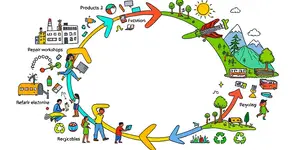Our planet stands at a critical crossroads: every choice we make leaves an environmental mark, often called a carbon footprint. This invisible trail of emissions accumulates with each mile we drive, every kilowatt-hour we use, and each product we purchase. By understanding the full impact of our actions and adopting small, everyday lifestyle decisions, we can join a global movement to curb climate change, secure natural resources for future generations, and foster a healthier world.
Understanding a Carbon Footprint
A carbon footprint represents the total greenhouse gases released—directly and indirectly—by an individual, organization, product, or event, measured in carbon dioxide equivalent (CO₂e). While often associated simply with CO₂, this metric can encompass methane, nitrous oxide, and other powerful greenhouse gases. By converting all emissions to CO₂e, stakeholders gain a clear, comparable view of their contributions to global warming.
These emissions fall into three categories: direct on-site releases, indirect energy-related emissions, and broader supply chain or lifecycle emissions. Grasping these distinctions empowers us to identify the most effective pathways for reduction.
Calculating Your Impact
Estimating your carbon footprint begins with data collection. You tally home energy consumption, transportation habits, dietary patterns, and waste generation, then apply standardized emission factors or leverage online calculators. For businesses and governments, more robust frameworks like comprehensive life cycle assessment approach trace emissions from raw materials through disposal.
By disaggregating emissions into these scopes, organizations can prioritize interventions and track progress over time, ensuring each reduction effort is measurable and impactful.
Global Context and Urgency
As the global population approaches 9.7 billion by 2050, our collective emissions surge. Today, industries such as fashion alone contribute around 10% of global greenhouse gases annually. Meanwhile, livestock farming emits vast quantities of methane, accelerating warming at a rate far higher than CO₂. These figures underscore an urgent truth: global greenhouse gas emissions demand immediate action across every sector.
Failure to reduce emissions threatens extreme weather, rising sea levels, and widespread ecosystem collapse. Conversely, every percentage point we trim from our collective footprint brings us closer to a resilient, sustainable future.
Why Reducing Your Carbon Footprint Matters
Lowering personal and organizational carbon footprints yields multiple dividends. A smaller footprint mitigates climate risks, conserves precious resources, and drives innovation in clean technologies. Consumers who demand low-carbon products encourage businesses to develop greener offerings, fostering a positive feedback loop that benefits society and the planet.
On an individual level, adopting more sustainable habits often enhances personal well-being: cycling replaces stressful commutes with energizing exercise, plant-rich diets improve health, and simpler living fosters mindfulness and contentment.
Effective Strategies to Shrink Your Footprint
Transforming intention into action requires practical, measurable steps. Below are three focused areas where small adjustments can yield significant gains:
- Food and Diet: Prioritize diverse plant-based protein sources such as legumes, nuts, and whole grains. Embrace local, seasonal produce to minimize transport emissions and avoid food waste.
- Clothing Choices: Move away from fast fashion by selecting durable items made from natural fibers. Explore second-hand, rented, or swapped garments to reduce demand for new production.
- Transportation Decisions: Opt for public transit, cycling, or walking over solo car trips. When flying, choose direct routes or consider sustainable aviation funds to offset emissions.
Beyond these areas, you can make meaningful improvements at home and online. Turning down your thermostat by just one degree can slash heating emissions, while unplugging idle electronics cuts standby power losses. Composting organic waste eases landfill burdens and regenerates soil nutrients, closing natural loops.
In the digital sphere, recognize that streaming, cloud storage, and data centers consume significant electricity. By managing file sizes, consolidating digital backups, and choosing services powered by renewable energy, you engage in simple, practical reduction strategies for cyberspace.
Home Energy and Waste Management
Residential energy use accounts for a sizable portion of household emissions. To optimize efficiency, upgrade to LED lighting, install smart thermostats, and switch to appliances with high Energy Star ratings. Consider solar panels or community renewable energy programs to decarbonize your electricity supply.
Waste reduction complements energy savings. Recycle paper, plastic, and metals; compost food scraps; and donate or repurpose items instead of discarding them. These actions not only shrink your carbon footprint but also conserve water and reduce pollution.
Tools and Resources
Assessing and managing your footprint has never been easier. Numerous free calculators from reputable environmental organizations guide you through personalized assessments based on your lifestyle and consumption. For businesses, software platforms provide real-time monitoring, sophisticated analytics, and automated reporting—enabling continuous improvement.
Seeking broader engagement, you can connect with local environmental groups, attend workshops on sustainable living, or advocate for policies that support carbon pricing, renewable energy mandates, and circular economy initiatives. Collective action magnifies individual efforts, turning grassroots momentum into systemic change.
The path to a low-carbon future is paved by consistent, mindful choices. Whether it’s adopting renewable energy at home, choosing a bicycle over a car for short trips, or supporting ethical brands, your voice and actions matter. Every decision reverberates through communities and supply chains, reinforcing a global shift toward sustainability. Embrace this journey with optimism: as we adapt, innovate, and collaborate, we can create a thriving planet where people and nature flourish in harmony.
References
- https://www.enelgreenpower.com/learning-hub/energy-transition/carbon-footprint
- https://css.umich.edu/publications/factsheets/sustainability-indicators/carbon-footprint-factsheet
- https://greenly.earth/en-us/blog/company-guide/carbon-footprint-definition-and-calculation-method
- https://www.epa.gov/ghgemissions/carbon-footprint-calculator
- https://www.brightlysoftware.com/blog/calculate-carbon-footprint
- https://youth.europa.eu/get-involved/sustainable-development/how-reduce-my-carbon-footprint_en
- https://www.iberdrola.com/sustainability/carbon-footprint
- https://en.wikipedia.org/wiki/Carbon_footprint










